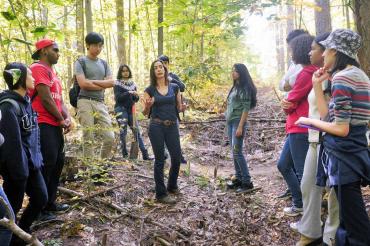Planning the future of forest science research and education at U of T

Published: May 25, 2017
The University of Toronto is seeking the community's input on the best way to support and enhance forest science research and education at U of T.
“This is a dynamic and changing field,” said Vice-President and Provost Cheryl Regehr. “With faculty and students now working on forest science research across all three campuses, we need to develop the best structure for supporting that research and education.
“Students today need access to a broad range of professors and research opportunities in this field – and we need to find a model that will ensure these programs can flourish.”
Today, U of T’s Faculty of Forestry has just seven full-time faculty members and 111 graduate students; there is no longer an undergraduate program within the Faculty. Sandy Smith, a forestry professor and former dean of the Faculty, wants the university to maintain a separate Faculty of Forestry after the consultations are complete. She said it is important for the university to continue its tradition of ground-breaking research.
“Forestry is in almost everything,” she said. “It's a key discipline for understanding how the world works.”
But a diverse range of faculties and departments at U of T is now engaged in forest science and related research − and interest among students and researchers across U of T is strong, the provost said.
She pointed to the Faculty of Applied Science & Engineering, home to U of T’s Pulp and Paper Centre, where researchers are working on converting forest biomass and mill effluents into alternative sources of energy, including methane and bio-ethanol.
“Important work is also underway at U of T Mississauga, at U of T Scarborough – and at the Faculty of Arts & Science, at the School of the Environment, the department of geography and planning, and the department of ecology and evolutionary biology,” Regehr said.
Some of that work takes place at the university’s Koffler Scientific Reserve at Joker’s Hill, a 350-hectare expanse of wetlands, fields and the largest old growth forest in the Oak Ridges Moraine.

Koffler is home to rigorous scientific experiments and a series of publicly accessible walking trails (photo courtesy of Koffler Scientific Reserve)
At U of T Scarborough’s Cadotte Lab, postdoctoral researcher Sebastian Seibold studies the effects of forest management and natural disturbances on biodiversity and how conservation measures can be integrated in forest management. And at U of T Mississauga, assistant professor of biology Ingo Ensminger studies certain varieties of trees at the molecular, leaf, species and ecosystem levels to understand why some adjust to a hotter and drier climate, while others can’t cope with the consequences of climate change.
For a current project, Ensminger is using a sensor-equipped drone to survey several experimental field sites of the Canadian Forest Service near Pickering and Quebec City, each the size of three football fields. The sensor monitors the fitness of thousands of tree seedlings based on changes in leaf pigmentation that are invisible to the human eye. His research could drastically reduce the time it takes to inspect these sites.
“Normally it takes several days to manually inspect how the seedlings compare,” he said. “With the drone, one can survey the site in 20 minutes and instead of going out to the site only once every two or three years, foresters can hopefully afford to go out several times every year. It increases the amount and accuracy of the data, and will improve tree breeding and forest management.”

Assistant Professor Ingo Ensminger is working on a project which involves using a drone to survey areas in Ontario and Quebec, each the size of three football fields, to detect changes in leaf pigmentation (photo courtesy of Ingo Ensminger)
Over the years, the university has developed expertise across a range of forest science disciplines, from silviculture to sustainable forest management and urban forestry – a term said to have been coined by former U of T Professor Erik Jorgensen in the 1960s. Among the researchers studying the growth and management of the city’s forests today is Tenley Conway, an associate professor in the department of geography at U of T Mississauga.
Conway focuses on how residents, community groups, municipalities and others interact with trees. One of her research projects, for example, examined the relationship between socioeconomic characteristics of residents and tree density.
“There’s a lot of interest in growing the urban forest right now, in planting more trees because they have potential to provide a lot of benefits to people in cities,” Conway said. “I hope my research adds some understanding about non-governmental actors and experts and how they interact with trees.
“That information could potentially be used to craft better programs and policies.”
As the world grapples with climate change and its consequences, the importance of forest science is “unquestionable,” Regehr said.
“We want to build on the university’s distinguished record of leadership in this field, and improve our ability to deliver research and teaching that is stable and sustainable.”
Until June 30, U of T students, staff, faculty, alumni and industry partners can submit feedback online in a first round of consultations. Professor Elizabeth Smyth, vice-dean, programs, at the School of Graduate Studies, is also holding a series of in-person consultations. The university plans to publish a discussion paper based on the first community survey, before launching a second round of consultations this fall.



